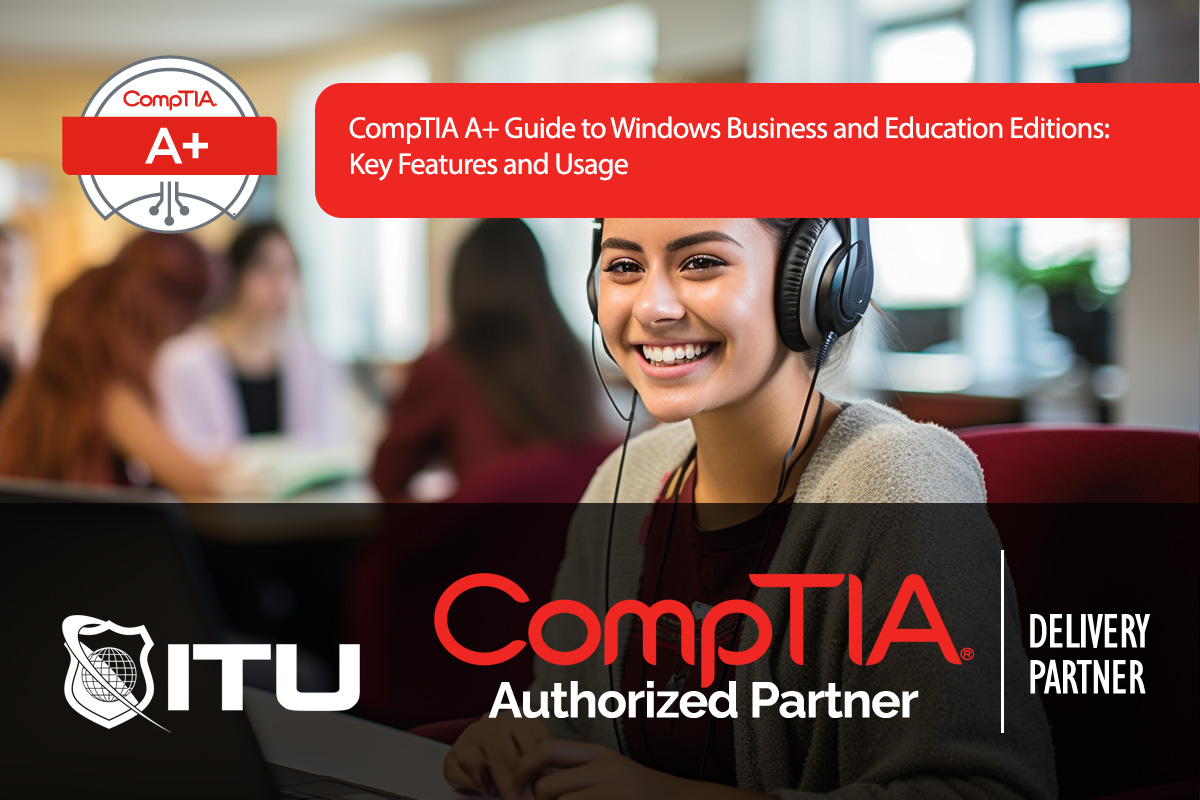What Is Access Control
Access Control is a security technique used to regulate who or what can view or use resources in a computing environment. It is a fundamental concept in security that minimizes

In preparing for the CompTIA A+ certification, understanding the distinct functionalities of Windows Business and Education editions is crucial. These editions—Professional, Enterprise, and Education—are tailored for corporate and educational environments, and they come with features that standard home editions lack. This blog covers the key components of Windows Business and Education editions, highlighting their exclusive capabilities and the reasons they’re integral in networked settings.
Windows Business editions are designed for advanced management and security requirements, making them ideal for work and educational environments. Unlike home editions, these versions support integration into corporate networks, advanced encryption, and remote management tools.
Windows Business and Education editions include a set of tools that make managing a secure, cohesive network environment possible, distinguishing them from Windows Home editions. Some of these features are:
Understanding 64-bit and 32-bit architecture is essential for CompTIA A+ certification and general IT management. Most modern systems and software are designed for 64-bit architecture, which supports larger amounts of RAM and can handle more intensive applications. Here’s what you need to know:
Windows Home and Business editions differ in terms of system limits, impacting performance and resource allocation:
One significant advantage of Windows Business editions is their deployment flexibility and ease of network integration. Through volume licensing, organizations can deploy hundreds of devices with a single license key, streamlining the setup process. Volume licensing also supports centralized updating, allowing IT administrators to manage updates, patches, and configurations from a central server.
For professionals preparing for the CompTIA A+ certification, it’s essential to understand the capabilities and limitations of each edition. This includes knowing which features are supported in home versus business settings, the importance of group policies, and the role of encryption for data security.
Windows Pro includes features not available in the Home edition, such as BitLocker encryption, Remote Desktop hosting, and the Group Policy Editor. These additions make Windows Pro essential for business use and are part of the CompTIA A+ knowledge base on managing security and network policies across multiple devices.
Yes, Windows Pro can be used at home. Although its advanced features—such as domain joining, BitLocker, and Remote Desktop—are designed primarily for corporate networks, home users may still find these useful for additional security and remote access options.
64-bit systems can support much higher RAM, up to 2 TB, and run both 32-bit and 64-bit applications, making them versatile for high-memory applications in business. In CompTIA A+, understanding the preference for 64-bit systems is essential due to their advantages in multitasking and performance over 32-bit systems.
BitLocker is a full-disk encryption tool included in Windows Business editions. It protects sensitive data by encrypting the entire drive, making it accessible only to authorized users. This feature is vital for CompTIA A+ certification as it demonstrates knowledge of secure data practices in business environments.
The Group Policy Editor allows administrators to set and enforce policies, like desktop restrictions and password rules, across a network. This tool is available in Windows Pro, Enterprise, and Education editions and is a key component in CompTIA A+ for maintaining uniform standards across business devices.
In participation with our Udemy Partner, enroll in the newest CompTIA A+ 2025 training course for only $12.99
Lorem ipsum dolor sit amet, consectetur adipiscing elit. Ut elit tellus, luctus nec ullamcorper mattis, pulvinar dapibus leo.
$49.99 Original price was: $49.99.$24.99Current price is: $24.99. / month with a 10-day free trial
Access Control is a security technique used to regulate who or what can view or use resources in a computing environment. It is a fundamental concept in security that minimizes
Active Directory (AD) is a directory service developed by Microsoft for Windows domain networks. It is included in most Windows Server operating systems as a set of processes and services.
Adaptive Security is a proactive approach to cybersecurity that anticipates and responds to evolving threats in real-time. Unlike traditional security measures that are often reactive and static, Adaptive Security continuously
Address Space Layout Randomization (ASLR) is a computer security technique used in operating systems to protect against buffer overflow attacks. By randomizing the locations where system and application executables are
An Advanced Persistent Threat (APT) refers to a prolonged and targeted cyberattack in which an unauthorized user gains access to a network and remains undetected for an extended period. Unlike
Agile Methodology is a project management and software development approach that emphasizes flexibility, customer collaboration, and the rapid delivery of workable software solutions. This methodology is built around the idea
Agile Software Craftsmanship is a methodology that combines the principles of Agile development with the ethos of software craftsmanship. This approach emphasizes the creation of high-quality software through iterative development,
Artificial Intelligence (AI) represents the branch of computer science that aims to create machines capable of intelligent behavior. At its core, AI is about designing algorithms and computational models that
An algorithm is a set of rules or instructions designed to perform a specific task or solve a problem. Algorithms are fundamental to the field of computer science, acting as
Algorithmic Game Theory is a discipline at the intersection of computer science, economics, and game theory that studies how computational resources can affect strategic interactions and decision-making processes. This field
Amazon Machine Image (AMI) serves as a foundational block in the vast ecosystem of Amazon Web Services (AWS), offering a pre-packaged operating system, application server, and applications required to launch
A NAND gate, one of the fundamental building blocks of digital electronics, stands as a testament to the power of logic synthesis and circuit design. Integral to the architecture of